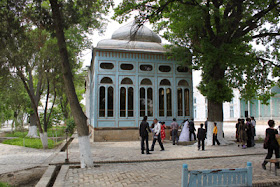 |
| Nilufar Nuriddinova |
Bukhara is well known as a museum city under the open sky with hundreds of monuments from different periods of history. Each monument of this extraordinary city possesses its own unique architecture, design and history.
The summer palace of the last Emirs of Bukhara, known by the poetic name Sitora-i Mokhi -Khossa, dates from the beginning of the 20th century. It is in the countryside, 4 kms to the north of the city.
 | |
| The stunning White Hall, image Richard Marshall |
Emir Nasrullakhan built the first summer palace here in the early 19th century. (This Emir is famous in the west as the ruler who imprisoned and eventually executed the British Great Game players Stoddart and Connolly in 1842).
According to legend, the Emir requested the aksakals (elderly wise men) to recommend a location for his summer residence. They told him to kill a lamb and separate it into four parts and hang the lamb pieces at the four corners outside the city. The piece that had been hung in the north was still fresh after some days and therefore the site was chosen as being the coolest area not too far from the city.
During construction, Nasrullakhan’s much-loved and beautiful wife Sitorabony, meaning “star” in Persian, died in childbirth. Nasrullakhan always compared her beauty to the moon. After her death the ruler decided to immortalise her by naming the palace Sitora-i Mokhi-Khossa or “A Star like the Moon”.
Nothing remains of this first palace. However, his grandson, Akhadkhan, built another palace on the grounds in the mid-19th century and maintained the name Sitora-i Mokhi-Khossa. The entrance portal, a striking example of Russian-influenced architecture, still stands.
The third summer palace built next to the second, fuses oriental and European (especially Russian) architectural styles. It was built by the order of the last emir of Bukhara, Said Alimkhan, and was completed in 1917.
 |
| Entrance portal summer palace, Bukhara |
The palace has three courtyards: hovli berun (outside), miyon hovli (middle) and hovli darun (harem). Traditional Bukharan houses always had two courtyards: the hovli berun, where men gathered, and the hovli darun for women. Each courtyard had its own gate; men never entered from the women’s section and women never from the men’s.
As Sitora-i Mokhi-Khossa was a palace, there were variations: the hovli berun (outside courtyard) was used for storage and workshops for the craft masters who made items for the Emir’s family and gifts for his guests. The second courtyard, the miyon hovli, was the main part of the palace or official part.
From the outside all the buildings at Sitora-i Mokhi-Khossa are in Russian style but the inside of each room is decorated in stunning, traditional Bukharan ornamentation and design. The rooms, each uniquely decorated, include the Emir’s bedrooms, the white hall (reception room), the chess room, the waiting room and the emir’s tearoom.
 |
| Rose garden, Bukhara summer palace, image: Urs Sieber |
The hall is lit by a huge chandelier brought from Poland; the door locks and door handles were brought from England and most of the furniture imported from Russia in the 19th century. Venetian mirrors can be found in the rooms and the tiles for fireplaces were brought from Germany. (The last emirs of Bukhara graduated from the military academy in Saint Petersburg and were quite taken with European architecture and décor).
Today the Emir’s glass-walled chaikhana (tearoom) houses an exhibition of 19th - 20th century porcelains, which Alimkhan keenly collected. His father, Emir Akhadkhan, was a passionate carpet collector and until the arrival of the Bolsheviks in Bukhara it is believed there were about 4000 carpets there, of which only a few remain today.
 |
| The glass-walled tearoom, image: Urs Sieber |
Going deeper into the garden one finds a courtyard with a two-story building with balcony and Russian style dome, a pond, a wooden pavilion and minaret. It was the harem. Downstairs in the two-story building there were bedrooms for the Emir’s wives and upstairs there was a kitchen, a terrace where they had their breakfast and dinner and a room for flowers.
Today the harem houses the Bukhara Museum of Applied Arts, where you can see outstanding examples of suzanis.
 | |
| View of the harem, image: Richard Marshall |
Contact Nilufar at: nilufar_nuriddinova(at) yahoo(dot)com
Related posts:
Bukhara's Puppet Theatre
Alexander 'Bokhara' Burnes - Great Game Player
Omar Khayyam in Samarkand and Bukhara
Kagan Palace, Near Bukhara, Uzbekistan
Bukhara's Contemporary Art Museum




